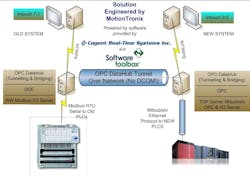OPC Solution Eliminates Downtime and Saves $21M
Motiontronix, a Wonderware Certified Systems Integrator located in Johannesburg, South Africa, and specializing in InTouch applications, eliminated at least 30 days of downtime for a food processor, saving $21 M dollars in lost production value at that site. For some upcoming projects at larger sites, the savings are expected to amount to over $57 M. This story tells how the integrator realized these incredible results. Motiontronix’s end-customer is a large food-processing mill in a remote location that operates 24 x 7. When upgrading control systems, key objectives are to minimize downtime and the number of visits to the client. Motiontronix’s goal was to maximize the customer’s production time while changing a control system’s programmable logic controller (PLC) hardware, by running the old and new systems in parallel. A recent project involved upgrading Wonderware InTouch software, as well as upgrading from old Modbus serial devices to new Mitsubishi Q series PLCs. In previous installations, this work was done in four days working 24 x7, since the old and new systems could not communicate in parallel and lost production had to be minimized. The extra costs and risk of error from such long shifts were high. The biggest problem during the changeover period occurred when an operator selected an operation from the old supervisory control and data acquisition (SCADA) system. Operators and engineers testing the new system could not see the changes. In an ideal situation the new system, consisting of the human-machine interface (HMI), PLC program and input/output (I/O) server, could be checked before taking the old system off line, and the systems could operate in parallel. However, this had not been achievable prior to the current solution. According to Rudi Van Der Merwe of Motiontronix, “The overall system normally consists of about seven to eight PLCs with approximately 3,500 I/O points. Assuming you take just one minute on each I/O point for checkout, you need about 60 hours to change from the old to the new system if there are not any problems. In reality, there are always problems, so changeovers would take even longer. Production time lost in the conventional method would have been a minimum of one-and-a-half to two months.” For the food processing mill, Motiontronix selected OPC tunneling, bridging, and server tools provided by Software Toolbox, based in located in Matthews, N.C., that allow the old and new control system to operate in parallel and share information so that operators would always know what was happening during a changeover.Says Van Der Merwe, “The OPC DataHub software is quick and does not slow the overall system down, and you do not have to rewrite tags. This makes it possible to change each PLC as needed and still keep the systems running in parallel. The other big advantage is that if we encounter any problems with the new system, we can switch back to the old system within 15 minutes, nearly like a totally redundant system. I would say that using the Software Toolbox solution results in no production loss vs. the 30 days of production loss with the previous method, which is where the $21 M in savings comes for our client in a small mill.”The solution Motiontronix found from Software Toolbox and its development partner, Cogent Real Time Systems, uses the TOP Server OPC Server and OPC DataHub tunneling and aggregation software to minimize downtime and configuration time while increasing performance. To complete the customer’s upgrade, Motiontronix used the TOP Server Mitsubishi Suite driver with its SuiteLink and OPC interfaces to provide data to the new InTouch application. The integrator uses the OPC DataHub to allow the two SCADAs to share data from the single driver across the network, without using Distributed Component Object Model (DCOM), a key consideration for reliability and ease of configuration and setup. As shown in the system diagram, this was accomplished by using one OPC DataHub node as a DDE Client on the personal computer with the existing system’s Wonderware Modbus I/O server. The second OPC DataHub node was used on the TOP Server PC as an OPC client talking to the TOP Server OPC and I/O Server. Using the tunneling, aggregation and bridging capabilities of the OPC DataHub, engineers were able to mirror the data across the network without DCOM, and bridge the OPC and DDE servers, thus sharing data between the SCADAs and allowing both systems to run concurrently.According to Van Der Merwe, “With us now having the two SCADAs share real-time information, and the programming tested, we can change over within an hour. This is done when the customer stops production for its normal eight-hour weekly maintenance per PLC. Certain PLCs in the system are mission critical for the operation of all the mills and the customer cannot afford to stop for long periods of time. There is also less pressure on engineering to complete each changeover, as all the wiring to get the two systems operating in parallel is done beforehand.”OPC DataHub is a trademark of Cogent Real Time Systems. Software Toolbox and TOP Server are trademarks of Software Toolbox, Inc.For more information on OPC solutions from Software Toolbox, visit www.softwaretoolbox.com/opc.

